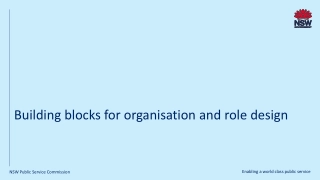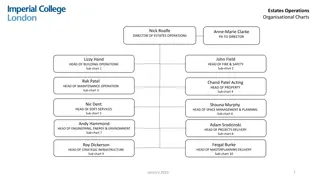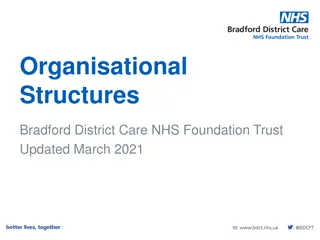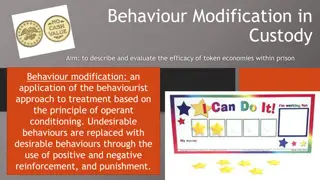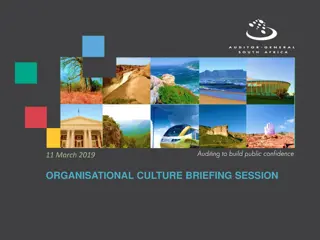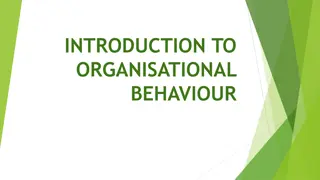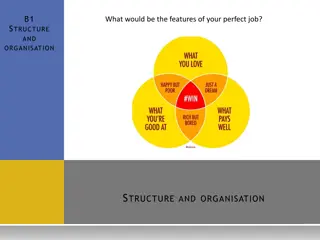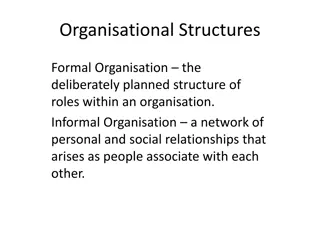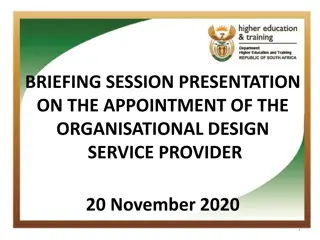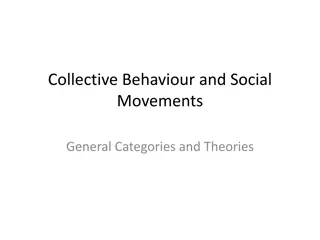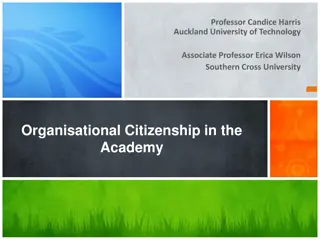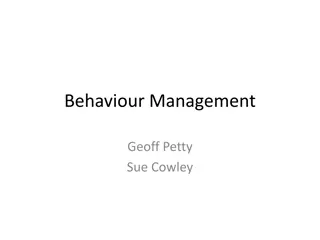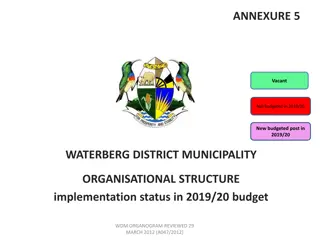Understanding Communication in Organisational Behaviour
Explore the concept of communication in organisational theory and behaviour, covering definitions, types, functions, theories, barriers, and effective communication skills. Delve into the disciplines contributing to organisational behaviour and the role of communication in decision-making. Gain insights into how communication fosters information exchange, conflict resolution, and team building in the workplace.
Download Presentation

Please find below an Image/Link to download the presentation.
The content on the website is provided AS IS for your information and personal use only. It may not be sold, licensed, or shared on other websites without obtaining consent from the author. Download presentation by click this link. If you encounter any issues during the download, it is possible that the publisher has removed the file from their server.
E N D
Presentation Transcript
Lecture 4 Communication Communication OrganisationalTheory & Behaviour BBA 420 University of Lusaka By Ngosa Chisupa
Learning Objectives Be able to define communication Explain Communication Process Define the different types of Communication Discuss the functions of Communication Explain the Communication Theories Discuss Barriers to Communication and How to overcome these barriers Discuss the effective communication skills By Ngosa Chisupa
OB Disciplines and their Contribution to Organisational Behaviour Behaviour Science Psychology Contribution Unit of Analysis Individual Learning, Motivation, Personality, Emotions, Perception, Training, Leadership Effectiveness, Values, Recruitment Group Dynamics, Work Teams, Communication, Power/ Conflict, Change Behaviour Change, Attitude Change, Communication, Group processes, Group Decision Making Comparative Values Comparative Attitudes Cross Cultural Cultures Political Science Conflict / Power, Influence Tactics Power and Ethics, Political Strategies Cross cultural analysis, values and morals Sociology Group Social Psychology Group Anthropology Organisation Group Organisation By Ngosa Chisupa
Defining Communication Definitions: The Process by which people convey and receive information to and from each other. Must include both transfer and understanding of meaning. Communication can be defined as the exchange of an information, thought and emotion between individuals of groups, in other words, communication plays a fundamental role in balancing individual and organizational objectives (Boyaci, 1996, p. 3-5). 5
Communication Defined Communication is the sharing of ideas, knowledge, feelings and perceptions. Within the workplace, communication takes place for a number of direct and indirect reasons. Competent communicators know and understand the elements and rules of communication. Their ability to communicate is reflected in the quality and range of their communication skills. By Ngosa Chisupa
Communication and Decision Making Making decisions requires the communication of information Phillip and Gully (2014) Communication is the foundation of all conflict resolution and team building, Said Hmaidan, Senior Information Officer at the World Bank Group. Communication is critical to employee motivation. By Ngosa Chisupa
What is Organisational Communication Organizational communication is a subfield of the larger discipline of communication studies. Organizational communication, as a field, is the consideration, analysis, and criticism of the role of communication in organizational contexts. ... Grapevine is a random, unofficial means of informal communication. 8
Communication in Organisations Communication is vital to organizations it s how we coordinate actions and achieve goals. It is defined in Webster s dictionary as a process by which information is exchanged between individuals through a common system of symbols, signs, or behavior. We know that 50% to 90% of a manager s time is spent communicating (Schnake et al., 1990), and communication ability is related to a manager s performance (Penley et al., 1991). In most work environments, a miscommunication is an annoyance it can interrupt workflow by causing delays and interpersonal strife. But, in some work arenas, like operating rooms and airplane cockpits, communication can be a matter of life and death. 9
Types of Communication Communication can be categorized into three basic types: (1) verbal communication, in which you listen to a person to understand their meaning; (2) written communication, in which you read their meaning; and (3) nonverbal communication, in which you observe a person and infer meaning. 10
Verbal Communication The following after the popular forms of verbal communication. Speeches Formal one on one Group discussions Amazon CEO Jeff Bezos, Twitter Monday meetings Informal rumor mill/grapevine By Ngosa Chisupa
Written Communication Letters Powerpoint Email Instant Messaging Text Messaging Social Media Websites Apps, Linkedin, Twitter Blogs, web log, ie blogging By Ngosa Chisupa
Non Verbal Communication Body Language, can convey status, emotional state, level of engagement.ie drumming fingers during performance appraisal may communicate anxiety, touch, eye contact Facial expressions, can convey, aggressiveness arrogance, fear, shyness etc Physical distance between the sender and receiver, role of cultural norms, aggressiveness, interest, disinterest, displeasure etc, By Ngosa Chisupa
Case Study Today writing skills are more important than speaking skills. By Ngosa Chisupa
Case Study (Cont) The ability to speak well particularly in English has become a job prerequisite for many multinational corporations. The good news is that speaking ability, knowledge of when to speak, how to speak, how to sound, what to say can be improved through training . Learning a foreign language for overseas assignments By Ngosa Chisupa
The Communication Process Communication fulfills three main functions within an organization, including coordination, transmission of information, and sharing emotions and feelings. All these functions are vital to a successful organization. The coordination of effort within an organization helps people work toward the same goals. Transmitting information is a vital part of this process. Sharing emotions and feelings bonds teams and unites people in times of celebration and crisis. Effective communication helps people grasp issues, build rapport with coworkers, and achieve consensus. 16
Downward and Upward Communication Upward communication flows to a higher level in the group or organisation. Its used to provide feedback to the higher ups, inform them of progress towards goals and relay current problems. Communication that flows from one level of a group or organisation to a lower level is downward communication . In downward communication, managers must explain the reasons why a decision was made. Upward communication keeps managers aware of how employees feel about their jobs, co-workers and organisations in general The problem with downward communication is that its usually one way By Ngosa Chisupa
Process Models of Communication The Process models of communication contains seven elements such;- Sender Message Receiver Feedback Channel Context or setting Noise or Interference By Ngosa Chisupa
Sender and Message Message The message is the idea of feeling transmitted from the sender to the receiver understanding. connection between the sender and the receiver and may be made up of signs, words and movement. Sender Communication begins with sender, the individual who reacts to situations from a unique vantage point, interpreting ideas and filtering experiences through their own perception. to achieve makes It a The tone of voice, inflection, the rate of speech, facial expression, touching and body movement may be misinterpreted by the receiver, or poorly constructed message may lead to misunderstanding. The message the sender meant to send is not always the message received. Sender conceives his ideas based on the accumulated attitudes, experiences, skills and cultural conditioning. By Ngosa Chisupa
Receiver The receiver decodes or interprets the message to achieve understanding. In doing this, the receiver also acts as an individual from a unique vantage point, interpreting the idea according to a particular personal perception of the message. This perception is also the result of the receiver s unique background of experiences, beliefs and concerns. Interpretation of the same message may vary between people. This is because individual perception is influenced by experience, attitudes, and beliefs and a range of acquired skills or expectations. For example, one person may perceive the color blue as cool, peaceful and confronting while another may perceive blue as old fashioned and formal. The particular or specific meaning is influenced by past experience. Even the context or setting of the communication affects perception. By Ngosa Chisupa
Feedback Feedback is an essential part of successful interpersonal communication. It is the receiver s response to the sender s message, telling the sender how their message is being received and helping the receiver confirm whether their perception of the message is correct. It can be intentional or unintentional. Feedback: - Provides continuity in the communication - Indicates effective understanding or misunderstanding of the message - Stimulates further communication and discussion By Ngosa Chisupa
Channel and Context Channel A communication channel is the means of techniques used to signal or convey a message for example, a conversation, letter, telephone call, e-mail or television program. An appropriate channel suits the communication purpose, the need of the sender, the message and the needs of the receiver. Context Context is the situation or setting within which communication takes place or the circumstances that surround a particular piece of communication. There are three dimensions in the context physical, social- psychological and the temporal.. By Ngosa Chisupa
Noise The message received is not necessarily the same as the message sent. Something other than the intended message is received because noise or interference interrupts the intended message. Noise or interference that interrupts the message or communication flow between sender and receiver can lead to misunderstanding or to confused or ambiguous communication. By Ngosa Chisupa
The Grapevine The informal communication network in a group or organisation is called the grapevine. Although rumours and gossip through the grapevine maybe informal, its still an important source of information for employees and job applicants. Grapevine is an important part of any group or organisation communication network. It serves employee needs, small talk create sense of closeness and friendship amongst those who share information. Managers can study the gossip driven largely by employee social networks to learn about information flowing in the organisation. By Ngosa Chisupa
Functions of Communication By Ngosa Chisupa
Functions of Communication 1) Emotive 2) Motivation 3) Information 4) Control By Ngosa Chisupa
Emotive and Motivation Functions Motivation A communication is to motivate, direct, control and evaluate the performance of organizational members. Leadership is an influence process by which supervisors attempt to control the behaviour and performance of subordinates. Communication is the major vehicle of such control available to leaders. Hence, leadership activities, such as issuing orders, behavior and reviewing and performance, making job and task assignments, and developing subordinates all involve communication second major function of Emotive Through employees can express their frustrations and satisfactions to each other and to management. In addition, provides a mechanism individuals to compare attitude and resolve ambiguous about their jobs, their roles and areas of conflict between groups and individuals. If an employee is dissatisfied with his pay, he will often communicate informally, to determine whether the feelings are justified or not. communication, communication for rewarding performance, evaluating with others training and By Ngosa Chisupa
Information and Control Functions Control Organizations are attempting to control the activities of individuals through the design and use communication channels. Information Communication vital information function for decision-making. serves a of formal It is based on technological orientation and information activities and ways to improve the accuracy communication channels carry information individual, group organizational decisions. Most types of programs or standard operating procedures have a large communication component to them. Hence, formal communication channels represent a major structural means of control organizations facilitates processing with which within going into and By Ngosa Chisupa
Communication Theories (1) Attribution theory is a psychological theory that attempts to explain some of the causes of our behavior. According to the theory, you want to be able to understand the reason for the actions you take and understand the reasons behind the actions other people take. You want to attribute causes to these behaviors, which should give you some felling of control over your own behaviors and related situations. 29
Three Stage Process of the Attribution Theory - Attributing behaviour is a 3-stage process: 1. You must observe the behavior, whether it is your own behavior or the behavior of someone else. 1. External cause or internal cause? Internal cause: Internal causes are those factors that are attributed to the person being observed. Internal causes are usually controllable. For example, a co-worker just received a promotion. You believe the reason for her promotion was her hard work, dedication, and skills. You have thus attributed internal causes to her promotion. External cause: External causes are attributed to factors outside of the person being observed. External causes are often not controllable, such as luck. For example, let's say your co-worker just received a promotion. You believe she received her promotion because the owner of the company is her father. You have attributed an external factor as the cause of her promotion. 2. You must determine whether the behavior being observed is intentional 3. You attribute the observed behavior. 30
Communication Theories Agenda Setting Theory Agenda Setting Theory states that mass media organizations determine what the general population considers newsworthy by deciding how much attention a news story receives. The term salience transfer is commonly used and refers to the ability of the media to transfer their agendas onto the public. 31
Barriers to Communication Semantic Problems Status Effects Physical Distraction Information Overload Time Pressures Cultural Differences Trust Levels Selective Perception Self Concept Absence of Two Way Communication By Ngosa Chisupa
Barriers to Communication Semantic Problems Status Effects Physical Distraction Information Overload Time Pressures Cultural Differences Trust Levels Selective Perception Self Concept Absence of Two Way Communication By Ngosa Chisupa
Stereotyping The most significant barrier to effective cross-cultural communication is the tendency of human beings to stereotype, or more specifically, to categorize and make assumptions about others based on identified characteristics such as gender, race, ethnicity, age, religion, socioeconomic status or nationality. Whether we realize it or not (and we often do not), we all stereotype and make assumptions about others at one time or another. 34
Examples of Stereotyping When job interviewers who reject certain candidates based on racial or gender stereotypes, Teachers/Lecturers who assume that certain students are less likely to succeed because of where they come from, Store owners who harass people from particular racial or ethnic groups. However, not all stereotyping is so blatant. More subtle examples include shying away from people who are culturally different (which is one of the reasons people from similar racial and cultural backgrounds tend to group together), Or assuming people will behave a certain way based on their race, gender, place of origin or position within an organization. 35
The Halo Effect The halo effect is a type of cognitive bias (Cognition - Processing of acquiring knowledge) in which our overall impression of a person influences how we feel and think about his or her character. Essentially, your overall impression of a person ("He is nice!") impacts your evaluations of that person's specific traits ("He is also smart!"). One great example of the halo effect in action is our overall impression of celebrities. Since we perceive them as attractive, successful, and often likable, we also tend to see them as intelligent, kind, and funny. 36
Examples of the Halo Effect A Candidate for employment who arrives punctually is smart in appearance and friendly may well influence the perception of the selectors, who then place less emphasis on the candidates technical ability, qualifications or experience for the job A new member of staff who performs well in his first major assignment may be perceived as a likely person for promotion, even though his assignment is not typical of the usual duties the member of staff is expected to undertake. A single trait such as good attendance and timekeeping, may become the main emphasis for judgement of overall competence and performance rather than other considerations such as the quantity, quality and accuracy of work. 37
Overcoming Barriers to Communication Information Communication and Information Centers Exception Principle and Need to Know Being Empathetic in Understanding Using Feedback Mechanisms Minimize Physical Distraction Active Listening Follow up and Feedback Parallel Channels and Repetition Timing Be Patient and Paying adequate attention By Ngosa Chisupa
Effective Communication skills Listening Skills, active listening, search for meaning Writing Skills, write to express and not impress, get to the point, use common language, back up your assertions Presentation Skills, speak up and speak clearly, channel nervous energy into an enthusiastic delivery Meeting Skills, leading meetings requires skills in organising, eliciting input from meeting participants, agenda, active participation , keep focused on agenda By Ngosa Chisupa



